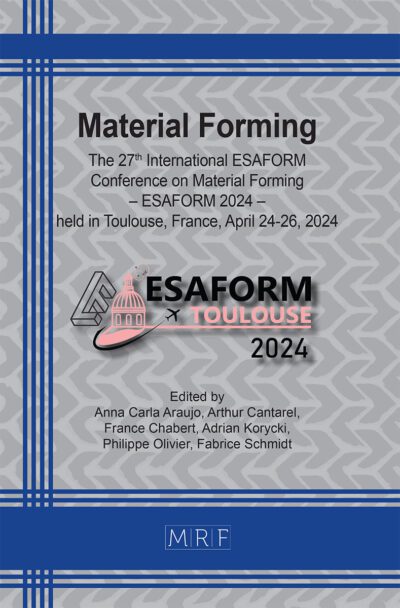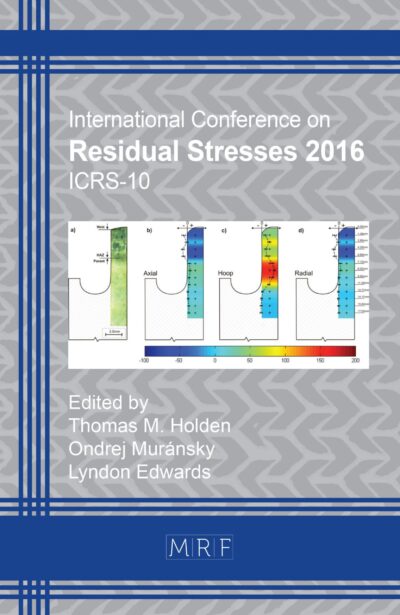Deep drawing effects of structured steel sheets with undercuts by cold rolling for interlocking joints
Aron Ringel, Karl Johann Tilly, David Bailly
Abstract. The multi-material approach combines the advantageous properties of different materials to reduce weight while maintaining key performance characteristics. However, joining of different material classes (e.g. steel, aluminum or plastics) remains challenging and new joining techniques have been developed to overcome the existing limitations. Metal-metal joints can be achieved by hybrid casting. Here, one material is added in a liquid state, which provides the possibilities of hidden joint areas and more complex geometries. In a similar way, direct assembly processes are used for metal-plastic joints. Both variants use surface structures to create an interlocking connection. One option to create structured surfaces is a modified cold rolling process that creates channel-like surface structures with undercuts. As automotive components have complex shapes, additional forming might be used before the casting or molding. This paper aims to show how cold rolled structures affect the forming limit up to failure during deep drawing and how the additional forming process affects those structures. DC04 steel sheets were structured by cold rolling, cut into plates, and deep drawn into cross cups. The design of experiments included unstructured sheets for benchmarking, as well as sheets with longitudinal and diagonal surface structures, with the structures positioned on both the inside and outside of the cups. The blank holder force and punch movement were adjusted to determine the forming limit. The plastic strains were estimated by a finite element (FE) ABAQUS model. Cross-section samples from the cup’s bottom, wall, and radius were analyzed to assess changes in the structure geometry.
Keywords
Interlocking, Multi-Material, Structured Cold Rolling, Deep Drawing, FE-Modelling
Published online 5/7/2025, 10 pages
Copyright © 2025 by the author(s)
Published under license by Materials Research Forum LLC., Millersville PA, USA
Citation: Aron Ringel, Karl Johann Tilly, David Bailly, Deep drawing effects of structured steel sheets with undercuts by cold rolling for interlocking joints, Materials Research Proceedings, Vol. 54, pp 1432-1441, 2025
DOI: https://doi.org/10.21741/9781644903599-155
The article was published as article 155 of the book Material Forming
![]() Content from this work may be used under the terms of the Creative Commons Attribution 3.0 license. Any further distribution of this work must maintain attribution to the author(s) and the title of the work, journal citation and DOI.
Content from this work may be used under the terms of the Creative Commons Attribution 3.0 license. Any further distribution of this work must maintain attribution to the author(s) and the title of the work, journal citation and DOI.
References
[1] R.S. Coelho, A. Kostka, J.F. dos Santos, A. Kaysser-Pyzalla, Friction-stir dissimilar welding of aluminium alloy to high strength steels: Mechanical properties and their relation to microstructure. Mater. Sci. Eng. A 556 (2012) 175–183. https://doi.org/10.1016/j.msea.2012.06.076
[2] K. Dröder, M. Brand, T. Gebken, M. Kühn, M. Böl, Increasing the interlocking effect between metal and FRP by mechanical undercuts. IJAUTOC 2 (3/4) (2016) 316. https://doi.org/10.1504/IJAUTOC.2016.084328
[3] G. Meschut, M. Merklein, A. Brosius, D. Drummer, L. Fratini, U. Füssel, M. Gude, W. Homberg, P. Martins, M. Bobbert, M. Lechner, R. Kupfer, B. Gröger, D. Han, J. Kalich, F. Kappe, T. Kleffel, D. Köhler, C.-M. Kuball, J. Popp, D. Römisch, J. Troschitz, C. Wischer, S. Wituschek, M. Wolf, Review on mechanical joining by plastic deformation. Journal of Advanced Joining Processes 5 (2022) 100113. https://doi.org/10.1016/j.jajp.2022.100113
[4] E.E. Feistauer, J.F. dos Santos, S.T. Amancio‐Filho, A review on direct assembly of through‐the‐thickness reinforced metal–polymer composite hybrid structures. Polymer Engineering & Sci 59 (4) (2019) 661–674. https://doi.org/10.1002/pen.25022
[5] A. Bührig-Polaczek, T. Röth, E. Baumeister, N. Nowack, and T. Süßmann, Hybride Leichtbaustrukturen in Stahlblech-Leichtmetall Verbundguss, FH Aachen, Bad Nauheim / Frankfurt (2006). https://doi.org/10.21269/133
[6] A. Ringel, G. Hirt, Bending behavior of structured steel sheets with undercuts for interlocking with Al die-cast metal. Int J Mater Form 17 (2) (2024). https://doi.org/10.1007/s12289-023-01797-6
[7] Y. Kajihara, Y. Tamura, F. Kimura, G. Suzuki, N. Nakura, E. Yamaguchi, Joining strength dependence on molding conditions and surface textures in blast-assisted metal-polymer direct joining. CIRP Annals – Manufacturing Technology 67 (1) (2018) 591–594. https://doi.org/10.1016/j.cirp.2018.04.112
[8] C. Hopmann, J. Schild, S. Wurzbacher, A.E. Tekkaya, S. Hess, Combination technology of deep drawing and back-moulding for plastic/metal hybrid components. Journal of Polymer Engineering 38 (6) (2018) 583–589. https://doi.org/10.1515/polyeng-2017-0354
[9] D. Joop, Präzisionsbestimmende Faktoren bei der Herstellung blechverstärkter Hybridstrukturen im Druckguss: Grenzflächenanalyse und Verzugsoptimierung, Gießerei-Institut, RWTH Aachen University, Aachen (2018). https://doi.org/10.18154/RWTH-2019-00954.
[10] A. Droste, P. Naughton, B. Bowser, J. Röttger, S. Burr, O. Imam, M. Zeitler, T. Heuft, A. Cawley, Bonded metal-plastic composite structures – the future of lightweight, cost-effective performance, SPE Automotive Composites Conference (2003).
[11] T. Kleffel, D. Drummer, Investigating the suitability of roughness parameters to assess the bond strength of polymer-metal hybrid structures with mechanical adhesion. Composites Part B: Engineering 117 (2017) 20–25. https://doi.org/10.1016/j.compositesb.2017.02.042
[12] S. Filiz, L. Xie, L.E. Weiss, O.B. Ozdoganlar, Micromilling of microbarbs for medical implants. International Journal of Machine Tools and Manufacture 48 (3-4) (2008) 459–472. https://doi.org/10.1016/j.ijmachtools.2007.08.020
[13] S. Ucsnik, R. Gradinger, A. Becirovic, A. Waldhör, Enhanced Performance of Steel-Aluminium Cast Nodes through Cold Metal Transfer. Mater. Sci. Forum 765 (2013) 736–740. https://doi.org/10.4028/www.scientific.net/MSF.765.736
[14] J. Blackburn, P. Hilton, Producing Surface Features with a 200 W Yb-fibre Laser and the Surfi-Sculpt® Process. Physics Procedia 12 (2011) 529–536. https://doi.org/10.1016/j.phpro.2011.03.065
[15] M. Kraus, P. Frey, T. Kleffel, D. Drummer, M. Merklein, Mechanical joining without auxiliary element by cold formed pins for multi-material-systems, Proceedings of the 22nd International ESAFORM Conference on Material Forming: ESAFORM 2019, AIP Publishing (2019), 50006. https://doi.org/10.1063/1.5112570
[16] S. Senge, J. Brachmann, G. Hirt, A. Bührig-Polaczek, Interlocking Multi-Material Components made of Structured Steel Sheets and High-Pressure Die Cast Aluminium, ESAFORM (2017), 190007. https://doi.org/10.1063/1.5008220
[17] A. Ringel, J. Lohmar, Optimization of the Surface Geometry in Structured Cold Rolling for Interlocking of Formed and Die-Cast Metal Components. DDF 414 (2022) 89–94. https://doi.org/10.4028/p-z54p05
[18] S. Senge, J. Brachmann, G. Hirt, A. Bührig-Polaczek, Evaluation of interlocking bond strength between structured 1.0338 steel sheets and high pressure die cast AlMg5Si2, in: Livan Fratini, Rosa Di Lorenzo, Gianluca Buffa, Guiseppe Ingaro, (Ed.), ESAFORM (2018), 40019. https://doi.org/10.1063/1.5034873
[19] L. Bruckmeier, A. Ringel, M. Erck, D. Bailly, K. Bobzin, H. Heinemann, A. Bührig-Polaczek, Investigation of the Compound Strength of Hybrid Casting Components with Different Variations of Coated and Undercut Sheet Metal. Inter Metalcast (2024). https://doi.org/10.1007/s40962-024-01359-9
[20] H.Y. Kim, S.C. Choi, H.J. Kim, S.M. Hong, Y.S. Shin, G.H. Lee, Forming limit of AZ31B magnesium alloy sheet in the deep drawing with cross-shaped die. Int. J. Mod. Phys. B 22 (31n32) (2008) 6045–6050. https://doi.org/10.1142/S0217979208051558













